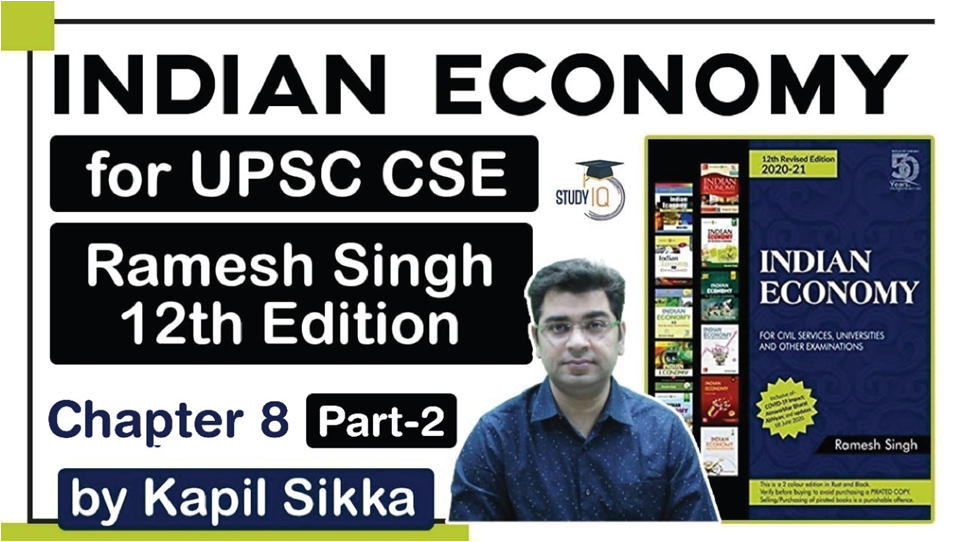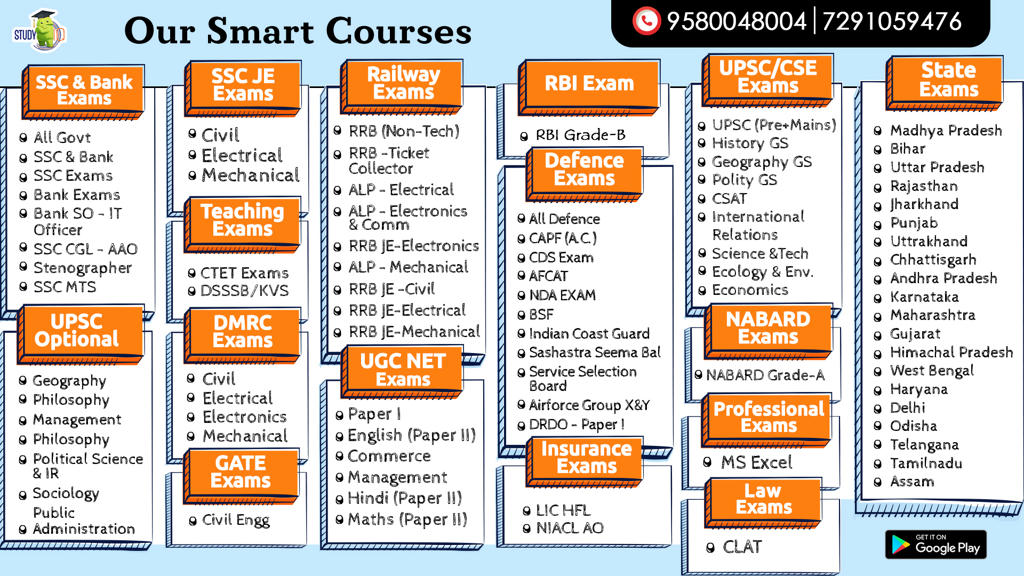Table of Contents
Agriculture And Food Management
Green Revolution
- 1960s
- Wheat
- Rice
Components of Green Revolution
- HYV Seeds
- Chemical Fertilizers (NPK)
- Irrigation
- Pesticides/Germicides
- Credit
Impact
- Socio Economic Impact
- Ecological Impact
- Water table
- Toxicity in Soil and food
Future
- Evergreen Revolution
- Doubling the farm income
Cropping Patterns
- Undergone significant changes
- Cultivated area remains more or less constant but the increased demand for food
Factors responsible for Cropping Patterns
- Geographical factors: Soil, landforms, precipitation, moisture, altitude, etc.
- Socio-cultural factors: Food habits, festivals, tradition, etc.
- Infrastructure factors: Irrigation, trans-port, storage, trade and marketing, post-harvest handling and processing, etc.
- Economic factors: Financial resource base, land ownership, size and type of land holding, household needs of food, fodder, fuel, fibre and finance, labour availability, etc.
- Technological factors: Improved varieties of seeds and plants, mechani-sation, plant protection, access to information, etc
Changes in Cropping Patterns
- Pre-Green Revolution Period
- socio-cultural and economic factors
- Green Revolution Period
- economic, infrastructural and technological (eg MSP)
- Reform Period
- 1991
- Zero Budget Natural Farming
- focus on irrigation water productivity to raise agricultural productivity
Animal Rearing
- Plays a vital role in the economy of the village
- It has remain an integral part Village economy
- It includes rearing of cows, camels, buffaloes, goats, pigs, ships, etc.
- It also contributes to the national income and socio-economic development of the country
Animal Rearing
- It Supplements the income of the family
- It generates gainful employment in the rural sector
- It helps the landless labourers and marginal farmers
- Gives alternative source of income to women
- Provides cheap nutritional food in villages
- Acts as cushion support during drought, famine and other natural calamities;
- Promotes inclusive growth
- Promotes sustainable agriculture

- It contributes about 29 per cent of the total agricultural, fishing and forestry sectors
- 9 Per Cent Growth Registered in Livestock Sector During Last Five Years
- 7 Per Cent Average Annual Growth Rate Registered in Fisheries Sector
- 06 Per Cent Average Annual Growth Rate in Food Processing Sector
- Economic Survey states that fisheries remain an important source of food, nutrition, employment and income in India.
- It provides livelihood to about 16 million fishers and fish farmers in the country.
- Fisheries sector has registered annual average growth rate of more than 7 per cent in the recent years.
- Recognizing the importance of the sector independent department of Fisheries has been created in 2019
Dairy Sector
- India continues to be the largest producer of milk in the world.
- Milk production in the country was 187.7 million tonnes in 2018-19 and registered a growth rate of 6.5 per cent over the previous year
- The per capita availability of milk has reached a level of 394 grams per day during 2018-19.
- Egg production in the country, which was 95217 million numbers in 2017-18, increased to 103318 million numbers in 2018-19.

- Dairy Sector
- Important Schemes for Milk Production:
- Intensive Dairy Development Programme.
- Strengthening Infrastructure for Quality and Clean Milk Production, Assistance to Cooperatives.
- Dairy Entrepreneurship Development Scheme.
- National Project for Cattle and Buffalo Breeding.
National Dairy Plan I
- It is a Central Sector Scheme.
- Fundingwas through a line of credit from the International Development Association (IDA),
- Fund will flow from Department of Animal Husbandry Dairying & Fisheries (DADF) to NDDB and in turn to eligible End Implementing Agencies (EIAs).
- NDP I had focused 18 major milk producing statesnamely Andhra Pradesh, Bihar, Gujarat, Haryana, Karnataka, Kerala, Madhya Pradesh, Maharashtra, Odisha, Punjab, Rajasthan, Tamil Nadu, Uttar Pradesh, West Bengal, Telangana, Uttarakhand, Jharkhand and Chhattisgarh which together account for over 90% of the country’s milk production.
Objective
- To help increase productivity of milch animals and thereby increase milk production to meet the rapidly growing demand for milk.
- To help provide rural milk producers with greater access to the organised milk-processing sector.
NDP 2
- 8000 cr layout
- expanding the coverage into uncovered areas.
- Today, there are about 3.20 lakh potential villages.
- Out of them, NBD 1 reached to about 2 lakh villages.
- About 1.25 lakh villages are still uncovered.
Other Schemes
- Rashtriya Kamdhenu Aayog to upscale sustainable genetic up gradation, production and productivity of cows.

Other Schemes
- Pig Rearing Scheme
- aimed to assist farmers/landless labourers/co-operatives and the tribals particularly in the North-Eastern states by rearing
- Encourage commercial rearing by adopting scientific methods and infrastructure creation;
- Create supply chain for the meat industry
- Encourage value addition for better income.
Food Management
- One of the most daunting task of government
- Twin Challenge of Food Production and Food Storage
- Government came up with various schemes since independence
Minimum Support Price
- Minimum Support Price (MSP) is a form of market intervention by the Government of India to insure agricultural producers against any sharp fall in farm prices.
- The minimum support prices are announced by the Government of India at the beginning of the sowing season for certain crops on the basis of the recommendations of the Commission for Agricultural Costs and Prices (CACP).
- MSP is price fixed by Government of India to protect the producer – farmers – against excessive fall in price during bumper production
- The minimum support prices are a guarantee price for their produce from the Government.
Minimum Support Price
- The major objectives are to support the farmers from distress sales and to procure food grains for public distribution.
- In case the market price for the commodity falls below the announced minimum price due to bumper production and glut in the market, government agencies purchase the entire quantity offered by the farmers at the announced minimum price.
Historical perspective of MSP
- Till the mid 1970s, Government announced two types of administered prices
- Minimum Support Prices (MSP)
- The MSPs served as the floor prices and were fixed by the Government in the nature of a long-term guarantee for investment decisions of producers, with the assurance that prices of their commodities would not be allowed to fall below the level fixed by the Government, even in the case of a bumper crop.
Historical perspective of MSP
- Procurement Prices
- Procurement prices were the prices of kharif and rabi cereals at which the grain was to be domestically procured by public agencies (like the FCI) for release through PDS.
- It was announced soon after harvest began.
- Normally procurement price was lower than the open market price and higher than the MSP.
- Discontinued now
Determination of MSP
- Commission for Agricultural Costs & Prices (CACP since 1985, earlier named as Agricultural Prices Commission) takes into account, apart from a comprehensive view of the entire structure of the economy of a particular commodity or group of commodities, the following factors:-
- Cost of production
- Changes in input prices
- Input-output price parity
- Trends in market prices
- Demand and supply
- Inter-crop price parity
- Effect on industrial cost structure
- Effect on cost of living
- Effect on general price level
- International price situation
- Parity between prices paid and prices received by the farmers.
- Effect on issue prices and implications for subsidy
Swaminathan Standard
- There are two formulae to calculate cost of production.
- One is to include cost of seed, labour (human, animal and machine), fertiliser, manure, insecticides and other miscellaneous costs which is denoted as A2 and add to it the family labour (FL).
- The other formula addition of cost on imputed rent and interest on owned land to A2+FL.
Swaminathan Standard
- So the final cost of production would be C2=A2+FL+cost imputed on rent and interest on owned land.
- The farmers have been demanding that MSP should be 1.5 times of C2, which was what the Swaminathan Commission had also suggested, and not 1.5 times of A2+FL
Q1. Consider the following statements regarding the cropping season in India
- The kharif cropping season is during the South-West/Summer Monsoon
- The rabi cropping season is during North-East/Returning/Winter Monsoon
- The crops grown between March and June are summer crops, known as zaid
Select the CORRECT statement(s) using the codes given below
- 1, 2 and 3
- 1 and 2
- 3 Only
- 2 and 3
Ans: 1
Explanation:
- All statements are correct.
- There are certain special terms used to understand the cropping seasons of India. The agricultural crop year in India is from July to June. The Indian cropping season is classified into two main seasons-
(i) kharif and (ii) rabi based on the monsoon. - The kharif crops include rice, maize, sorghum, pearl millet/bajra, finger millet/ragi (cereals), arhar (pulses), soyabean, groundnut (oilseeds), cotton, etc.
- The rabi crops include wheat, barley, oats (cereals), chickpea/gram (pulses), linseed, mustard (oilseeds) etc.
Q2. Consider the following pairs with regard to the classification of agricultural holdings
- Economic Holding – Maximum size of the holding which must be possessed and owned by a family
- Family Holding – It is a ‘plough unit’ which is neither less nor more for an average size family to cultivate it properly
- Optimum Holding – It is that holding which ensures a minimum satisfactory standard of living in a family
Select the INCORRECT pair(s) using the codes given below
- 1 Only
- 1 and 3
- 2 and 3
- None of the above
Ans: 2
Explanation:
- Pairs 1 and 3 are matched incorrectly.
- Agricultural holdings have been classified into three categories:
- Statement 1: Economic Holding: It is that holding which ensures a minimum satisfactory standard of living in a family. In other words, economic holding is a minimum essential area for profitable agriculture.
- Statement 3: Optimum Holding Maximum size of the holding which must be possessed and owned by a family is called optimum holding.
- Statement 2 is correct: Family holding is that holding which gives work to an average size family having one plough under the traditional farming system.
Q3. Which of the following is not true about the impact of Green Revolution?
- Food production increased in such a way that many countries became self-sufficient
- Among Indian farmers, it reduced the inter-personal as well as inter-regional inequalities
- The most devastating negative impact of the Green Revolution was ecological
- None of the above
Ans: 2
Explanation:
Socio-economic Impact of Green Revolution:
- Food production increased in such a way (wheat in 1960s and rice, by 1970s) that many countries became self-sufficient and some even emerged as food exporting countries.
- But the discrepancy in farmers’ income, it brought with itself increased the inter-personal as well as inter-regional disparities/inequalities in India.
Indian Economy | Free PDF






















 WhatsApp
WhatsApp